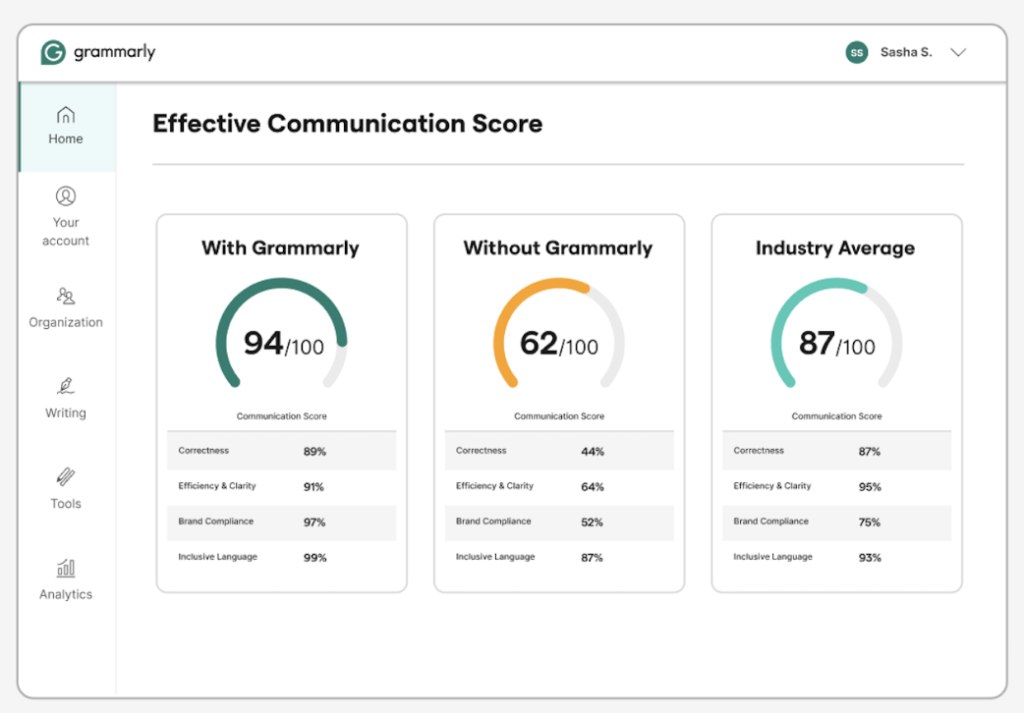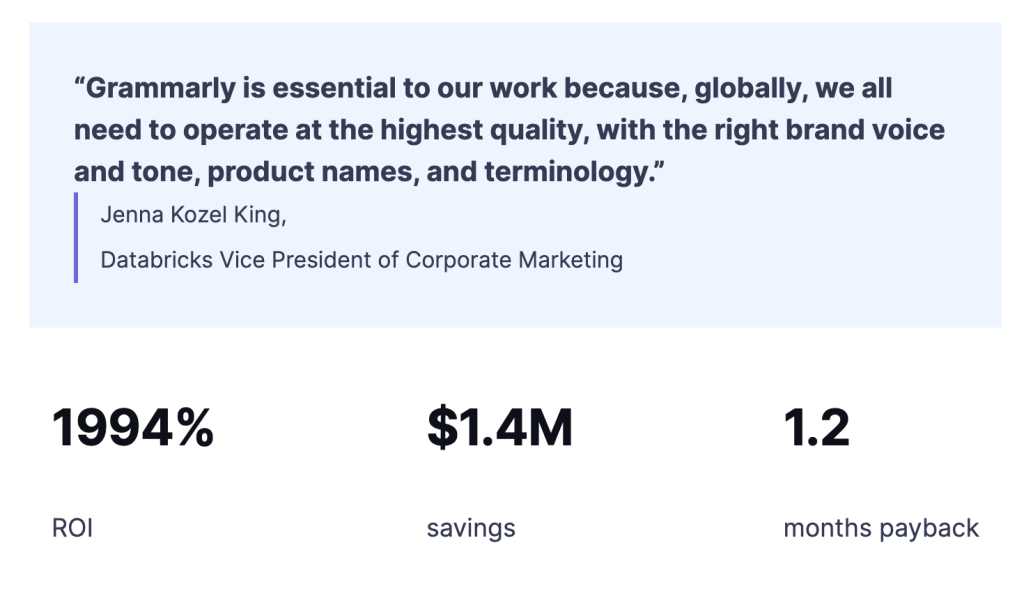In a landscape where the tangible impact of AI remains elusive for many organizations, Grammarly’s new ROI tools are a bold move to quantify the value of effective communication — at a time when it is much needed. The company’s recent announcement of tools to measure the Return on Investment (ROI) of AI in communication effectiveness marks a significant step forward in the enterprise AI space.
AI Measurement Addresses a Critical Need
The timing of this release by Grammarly is particularly apt. With 41% of organizations struggling to define and measure the exact impacts of their AI efforts, Grammarly’s new ROI tools directly address a significant pain point in the industry. The introduction of the Effective Communication Score and the ROI Report demonstrates a sophisticated understanding of what enterprise customers truly need: concrete metrics that tie AI-driven communication improvements to business outcomes.
Breaking Down Grammarly’s New ROI Tools
Grammarly’s Effective Communication Score is a first-of-its-kind metric in the industry. Measuring key aspects such as communication correctness, efficiency and clarity, brand compliance, and inclusive language provides a holistic view of an organization’s communication health. This multifaceted approach allows companies to identify specific areas for improvement, rather than relying on vague notions of “better communication.”

Image source: Grammarly
The Effective Communication Score reports on each of the below metrics, and also delivers a cumulative score:
- Correctness of the communication
- Efficiency and clarity of the writing
- Adherence of written content to the company’s brand guidelines (i.e. tone, voice, style)
- Inclusivity measurement based on the company’s diversity and inclusion standards
Grammarly’s ROI Report takes this a step further by offering customizable reports that demonstrate the impact of Grammarly on key business metrics. This level of customization is crucial, as it allows organizations to align the tool’s benefits with their specific goals and KPIs. Even better, organizations can (and should) test the efficacy of Grammarly by comparing customer support agents who use Grammarly versus those who do not and/or testing email campaign effectiveness with and without the use of Grammarly, as well as by watching CSAT scores. These key business metrics, covered by the ROI Report, will go a long way toward demonstrating concrete business value, which is exactly what organizations seek to justify their investment in AI-powered solutions.
Demonstrating Value: The Databricks’ Case Study
As mentioned, demonstrating the value of AI-powered solutions throughout the enterprise is challenging for most organizations today. That’s what makes the Databricks’ case study published earlier this year of particular interest, as it explored the time-savings and financial impact of the integration of Grammarly throughout the enterprise.
Databricks is an organization of some 6,000 plus and invested in Grammarly licenses across its Marketing, Sales, CX/Support, Finance, IT, Engineering, and Legal teams. One of the company’s goals when integrating Grammarly for Business across the enterprise was related to brand identity. The company wanted to facilitate alignment on communication standards and create a company-wide style guide utilized by Grammarly that would allow employees to adhere to a singular brand voice.
Another goal with the deployment of Grammarly was as an assist to the marketing/content development team. Databricks’ in-house editorial team is relatively small, but the team produces a massive amount of content. Since the deployment of Grammarly, the editorial team reportedly cut editing cycle times by 50%, saving an average of 15 minutes per document, and collectively saving writers and editors 540 hours of time.
Last, but not least by any measure, the Databricks’ study shared that the use of Grammarly by the customer support team, who are largely non-native English speakers, delivered results as quickly as a week after implementing Grammarly. The Databricks customer experience/support team reported improving time to resolution by 25%, along with an increase in average number of cases closed by 10 to 15%. Databricks also shared that the use of Grammarly in the customer support team’s hiring and onboarding processes saved the company an estimated $8,000 annually in employee productivity and an estimated $50,000 annually in soft skills training.
Databricks also credited Grammarly with helping accelerate employee upskilling, review development, and speeding and simplifying onboarding. All in, Databricks reports saving an estimated $1.4 million annually as a result of the deployment of Grammarly throughout the enterprise.

I share this case study as a reminder that if organizations are not measuring the impact of the AI-powered tools that they are integrating into the tech stack, there’s no concrete way of knowing what kind of ROI the tools are delivering. That’s Grammarly’s launch of these new measurement tools is well-timed.
Looking Ahead for Grammarly
Grammarly’s roadmap for future innovations is equally impressive. The planned features, such as suggestions to improve results, reports on enterprise-wide AI usage, and insights into organizational communication health, indicate a deep commitment to evolving alongside customer needs. These forthcoming tools have the potential to provide even more granular and actionable insights for enterprises looking to optimize their AI investments.
Market Implications
For the broader AI industry, Grammarly’s new ROI tools launch raises the bar as it relates to demonstrating value. I see this as a no-brainer: as enterprises become more discerning about their AI investments, tools that can clearly articulate their impact on the bottom line will no doubt gain a significant advantage. This could — and should — prompt other AI companies, particularly those in the productivity and communication space, to develop similar measurement capabilities.
Challenges and Considerations
While the potential of these tools is significant, their effectiveness will ultimately depend on how accurately they can measure and attribute improvements to Grammarly’s AI. The complexity of communication and the myriad factors that influence business outcomes mean that establishing clear causal relationships could be challenging.
Additionally, as with any tool that measures employee performance, there may be privacy and ethical considerations to navigate. Grammarly and its enterprise clients will need to ensure that these tools are used in a way that respects employee privacy and fosters a positive work environment.
Another important challenge ahead for Grammarly is that competitors aren’t sitting still. Google’s Gemini for Workspace aims to provide writing assistance (among other things), and I get constant and regular reminders from Perplexity that they would like to help supercharge my writing. These aren’t the only two competitors, but rather two who happen to be top of mind. This is a rapidly evolving space, and everyone is fighting for those enterprise AI budget dollars. As such, continuing to innovate at a rapid pace and working to deliver solutions that competitors aren’t yet thinking about will be important for Grammarly moving forward.
Conclusion
Grammarly’s new ROI tools represent a significant leap forward in the quest to quantify the value of AI in enterprise settings. By providing concrete metrics and customizable reporting, Grammarly is not just selling a product, but offering a way for businesses to justify and optimize their AI investments — which is incredibly important today.
What I see as unique about Grammarly’s approach is its focus on real-world applications. By working directly within the applications professionals use daily, Grammarly has positioned itself to provide deep insights into the communications that drive team success. This integration allows for a more accurate and comprehensive analysis than what might be achieved through surveys or general efficiency claims.
As Grammarly’s new ROI tools roll out to enterprise customers in the coming months, they have the potential to reshape how businesses think about and measure the impact of AI-driven communication improvements. For tech leaders and decision-makers, Grammarly’s innovation serves as a compelling example of how AI companies can — and should — align their offerings with tangible business outcomes. Grammarly’s enterprise customers can get early access to the Effective Communication Score and ROI Report in November of 2024
Wondering how you can get access to Grammarly’s new ROI Tools? Enterprise customers can gain early access to the Effective Communication Score and ROI Report beginning November 2024 by contacting their account manager. The Effective Communication Score will be available to Grammarly customers with Enterprise plans in their analytics dashboard by early Q1 2025. Find more information here.
Other related coverage:
Grammarly’s New Enterprise Features Put Gen AI Comms at Users’ Fingertips
Grammarly’s Enterprise Features Make Deploying Gen AI Secure, Easy, and a No-Brainer
Grammarly’s Strategic Suggestions Launch Signals the Company is Far More than an Editing Solution



